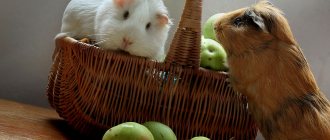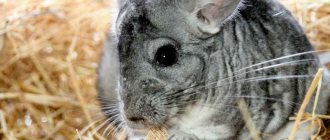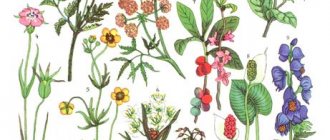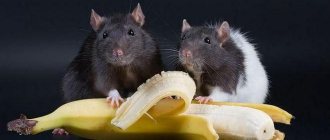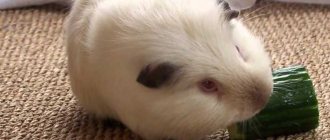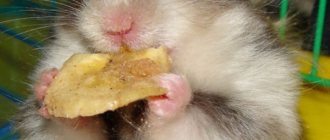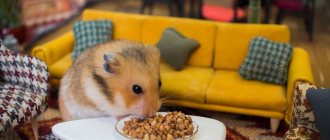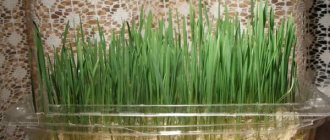- home
- Chinchilla
- Nutrition
04/01/2019 On the rocks where chinchillas live in the wild, vegetation is rather sparse.
However, the diet of rodents is varied: cereals, legumes, lichens, cacti and, of course, branches of shrubs and tree bark. When raising animals at home, in addition to vegetables, fruits and hay, you need to give chinchillas twigs. The food of rodents will be complete if you add young shoots and greens to the food in the summer and dried branches in the winter.
But first we need to find out which trees and shrubs are suitable for the animal to eat, as well as how to provide it with this food in the winter.
What trees can a chinchilla
Why does a chinchilla need twigs in its diet? There are several reasons for this:
- In this way, the rodent’s body can receive minerals, as well as nutrients necessary for the development of the body and health;
- The twigs help improve the condition of your pet's teeth;
- Using twigs as toys is one of the fun things for a chinchilla.
If you want to know what branches you can give to a chinchilla, then you should know the following:
- You can collect twigs for your pet yourself only in places that are environmentally friendly. You cannot collect twigs near the road, but the forest may be suitable;
- It is best to organize the collection of twigs for your pet during the so-called growing season;
- It is imperative to make sure that the windmills you assemble are free of any fungi or various kinds of parasites;
- At home, after collecting the twigs, you need to rinse them well under hot and also cold water, and then dry them thoroughly;
- It is necessary to keep the twigs you collect for your chinchilla in places where there is a low level of moisture;
- The bark on the branches contains a large amount of substances useful for the animal, so it should be left.
These tips should be followed by every owner of a small furry animal.
Boiled puree
Long-eared animals love boiled puree even more than raw vegetables. The concentration of sugar in it becomes greater, but the beneficial substances do not go anywhere. Start giving this puree to your rabbits, and also add it to the feed. Even if rabbits don’t particularly like it, with mixed puree everything will be eaten clean. In addition to cooking, use oven baking. Bake, as well as boil, should be done without adding salt and spices. Then you should grind it with a grater, mortar, fork or blender.
Seeds are also very important to introduce into the diet, but remember that different amounts of seeds are needed for rabbits and baby rabbits, since the concentration of vitamins there is very high and it can harm their well-being. Give adult rabbits 4-5 pieces per day, and baby rabbits need to chop 1-2 and add them to their food.
Pumpkin tops have enough fiber to be included in a rabbit's diet. And the rabbits themselves will be happy to chew on the juicy shoots. It turns out that pumpkin is a waste-free raw material - everything goes into feed, making it varied.
Tip: Be sure to include ripe orange pumpkin in your diet if you are raising red-coated rabbits. With sufficient consumption, wool becomes not only softer, fluffier and of higher quality, but also a brighter color - this is due to the presence of beta-carotene in large quantities.
What trees can be given to chinchillas?
It is worth noting one important point - both trees and shrubs cannot be offered to pets on an ongoing basis.
What branches can chinchillas eat?
- Viburnum - branches of this shrub for a chinchilla can be given 2 pieces once a week;
- Hawthorn - branches of this bush are given to the furry animal one or two pieces per week. Please note that the branches must first be processed: remove all thorns and leaves from them;
- Gooseberry - branches of this shrub can be given to pets three pieces per week. It is necessary to remove all thorns on the branches in advance;
- Sea buckthorn - for chinchillas, give one sprig once or twice every seven days. Leaves on the branches are removed in advance;
- Mulberry - chinchillas are usually given one sprig for food once every seven days;
- Willow - a branch of this tree for a chinchilla is given once in the amount of one piece every fourteen days;
- Hazel - it is recommended to give your pet one sprig twice a week.
What branches should not be given to chinchillas?
Knowing which tree branches can be given to chinchillas, you don’t have to worry about the health of your pet. Pay attention to those branches that should not be given to chinchillas:
- All branches of coniferous trees;
- Twigs of citrus trees;
- Plum branches;
- Apricot sprigs;
- Cherry twigs;
- Twigs of any tree that has resinous wood;
- Lilac branches;
- Sprigs of buckthorn;
- Maple branches;
- Elderberry sprigs;
- Bird cherry twigs.
Rules for self-harvesting branches
When buds appear on the trees, you can begin harvesting branches. They are cut with pruning shears. The sap moving through the trees at this time has the most valuable nutritional composition.
- Only living branches are taken from healthy trees and shrubs. Animals that are dried out, dirty, moldy or have marks of teeth cannot be cut off. The stems of raspberries, gooseberries, and hawthorns must be cleared of sharp thorns so that the animal does not injure the oral cavity.
- The branches (about 1 cm in diameter) are divided into parts 5-7 cm long. This size is convenient for a chinchilla, who eats while sitting and holding the treat in her front paws.
- The chopped twigs are washed well and doused with boiling water. Dry in the oven, placing it on a baking sheet in a thin layer.
- The oven door is left slightly open. The sticks are checked and mixed periodically.
- Completely dried branches are stored in cardboard boxes. Plastic containers are not suitable for this; they can become moldy there. Well-dried wood will not mold. However, after a few weeks you need to check the twigs - those infected with mold are thrown away, the rest are dried.
What are the benefits of wood for chinchillas?
It is worth familiarizing yourself not only with information about what branches can be given to chinchillas, but also finding out what the benefits of wood are for the chinchilla’s body.
Tree greens typically contain a high percentage of protein, ranging from 8% to 15%. Protein for furry animals is necessary for the development of muscle mass and the growth of the pet’s body as a whole. Tree greens also contain fats and fiber, which are necessary for the stable functioning of the chinchilla’s intestines.
Consumption of leaves
You can also introduce the leaves into your chinchilla's diet. Dried or dried leaves are ideal. Fresh food is also acceptable for rodents, but no more than 4-5 small pieces per 7 days.
These must be young leaves of such trees:
- Birch. Regular use provides an antibacterial effect and stimulation of life processes. Acceptable all year round, without restrictions.
- Oak. Helps cope with gastrointestinal disorders. Give as needed, but no more than 1-2 leaves per day. Large doses may cause constipation.
- Aspen. The leaves make a wonderful addition any time of year. They are valued for their high content of healthy proteins and fats.
- And you. Healthy and nutritious. You can feed your pet all year round, there are no restrictions.
- Poplar. It is nutritionally superior even to forage grasses. The leaves can be eaten year-round, but animals are usually not very willing to eat them.
We suggest reading how to properly care for chinchillas at home.
Tree branches as toys
It is also worth noting that branches of various trees are often used as toys for chinchillas. The animals are quite active by nature. They just need something to do while they are in the cage. If a chinchilla gets bored, bad habits may develop as a result, for example, one of the most common is fur pulling.
The appearance of bad habits in a pet will ultimately negatively affect the general physical condition of the chinchilla. Therefore, it is so important that every owner takes care of the presence of tree branches in his pet’s cage.
Chinchillas can tinker with tree branches in their cage for a very long time, which will provide them with a fun activity for a fairly long period of time and will not let them get bored if the owner for some reason cannot pay attention to his animal.
Vitamin supplements to complement your diet
Additional vitamins are given to animals in case of malnutrition, young animals, females during pregnancy and lactation, and also in case of illness. They are available in various forms, but it is easier to add liquid vitamin supplements to water. Some manufacturers produce food fortified with vitamins.
Owners sometimes sprinkle 2-5 grams of dry yeast as a source of protein and vitamin B. Various types of mineral and salt stones are placed or suspended in a cage where they scrape the teeth and replenish the mineral balance in the body.
Familiar treats
The most accessible are walnuts, so we will begin to consider this issue with them. Veterinarians differ in their answer to the question: Do chinchillas need walnuts?
Some experts believe that nut kernels are an excess in the diet, while others argue that nuts must certainly be present. It is worth watching your pet when introducing this type of nut into its diet.
Skin pathologies
The following types of skin diseases are distinguished in chinchillas:
- Lichen.
- Ectoparasites.
- Gnawing of fur.
Lichen
The biggest concern for the chinchilla and its owner is lichen. Humans are also susceptible to this fungal disease. Pathological fungi are ubiquitous, and under optimal housing and feeding conditions they do not cause disease. Warmth and dampness are required for their development. When kept in groups, the fungus, passing through many organisms, significantly increases its virulence, causing mass diseases. With lichen, itching, peeling of the skin, and the appearance of areas of baldness are observed. External antimycotics used in veterinary practice for treating small domestic animals are effective in treatment.
Along the way, they find out whether the animals are properly kept and fed. The shortcomings are eliminated. Perhaps the cause of dermatitis is not a fungus, but hypovitaminosis. Chinchilla breeders report that immunization with an anti-lichen vaccine helps with lichen. This fact has not received official confirmation, therefore, before conducting such experiments, you should consult a veterinarian.
Ectoparasites
The disease is characterized by itching, hair loss, and restlessness of the animal. Fleas come from other pets. Many insecticides that are harmless to other pets are toxic to rodents, so chinchilla breeders recommend bathing them in Bromocyclen solution and using flea collars for kittens and puppies. At the same time, owners need to take care of eliminating fleas in the apartment.
Gnawing fur
Chinchillas begin to chew out hairs due to an unbalanced diet, poor living conditions, or as a result of disruption of the functioning of the endocrine glands. Alopecia occurs throughout the body, damaging the skin. The situation can be corrected by switching chinchillas to professional balanced food. If isolated cases are identified, the sick ones are removed so that other animals do not follow their example.
Natural springs
Pamper your pet with a vitamin treat. To feed the animal you can use:
- Dry berries of rose hips, hawthorn, sea buckthorn;
- Branches of currant, raspberry, willow, linden, chicory shoots, dandelion leaves;
- Ready-made additives for rodents, which are sold in specialized stores.
However, the most useful vitamins will be those found in cereals, dried fruits and vegetables:
- Vitamin A is found in carrots, sweet peppers, apricots, dried apricots, spinach, red rowan;
- B vitamins - in cereal grains (wheat, oats, buckwheat), seeds, peas;
- Vitamin C - in green grass, sorrel, spinach, dill, and in almost all berries and fruits;
- Vitamin E - in sprouted wheat grains, soybeans, almonds, peanuts.
For good vision you will need vitamin A; for a fluffy coat, enrich your chinchilla’s diet with ascorbic acid. Calcium and phosphorus are responsible for the strength of teeth; there are many of them in apples, soybeans, beans, and dried apricots. The diet of young chinchillas is additionally enriched with bone meal, chalk, and fish oil to prevent rickets.
Melon seeds
Any seed contains enormous energy. That's why birds and rodents love them so much.
Raw pumpkin seeds, zucchini seeds, watermelon seeds, and melon seeds are very useful for chinchillas.
But the owner of the rodent must observe the measure. A pet needs from 5 to 7 melon seeds per day.
Important! All seeds that the owner wants to feed his pet must be fresh, slightly dried.
Feeding recommendations
When organizing food, it is not enough to know what you can feed a chinchilla and what you cannot feed. Proper feeding also means following a diet, keeping feeders and drinkers clean, as well as understanding the peculiarities of the animal’s digestion
The first and most important rule is that there should always be hay in the cage, as well as drinking water. Feeders and drinkers must be clean
To do this, they must be disinfected regularly (at least twice a week) with boiling water. It is better not to use wooden feeders - they absorb odors and become sources of mold and mildew. Preference should be given to ceramic ones, which attach well to the cage and are easy to clean.
Chlorhexidine can be a disinfectant for the entire cage - it kills germs well and is odorless, but it is better not to use it for drinkers and feeders. Some breeders use regular laundry soap as a disinfectant. You can also wipe the drinking bowls and feeders, as well as the cage, with alcohol. It is also necessary to keep the cage clean because sometimes the animal prefers to eat on the rest area or even in the house. Many owners have noticed how a chinchilla takes a piece of food and runs for cover.
It is also important to ensure that all feed is fresh, clean, and free of dust, rot, and mold. It is recommended to buy ready-made food only from trusted pet stores.
All succulent food, as well as lettuce or spinach, must be washed well before being given to the animal. Branches and bark of trees that are offered to your pet must be well dried and free of traces of insect activity.
Vegetables and fruits intended for chinchillas must be washed and cut into convenient small pieces.
It is necessary to feed your pet at the same time, and all leftover food is removed from the feeder the next day. It is most preferable to feed roughage in the evening, and succulent feed in the morning. If the chinchilla is reluctant to eat, you should change the food. The first reason for poor appetite is monotonous food. New types of feed should be introduced gradually and little by little. If you are not sure whether chinchillas can eat this or that type of product, it is better to abandon it altogether and add something that the animal has already tried and eats with pleasure.
Diet example
A person will not like to eat the same food every day.
Not everyone can eat buckwheat for a week, for example. So why subject your pet to the same torment? A chinchilla needs a complete and varied diet. It will not only be tasty for the animal, but also healthy. Do not forget that the pet is fed once a day in the evening, when the animal is awake. On the first day, you should give your pet 15 g of granules. 5 g of rose hips and the same amount of a mixture of corn and sunflower seeds will help supplement the required daily amount of food.
The second day is 20 g of granulated food and 10 g of dried apple.
The diet for the next day consists of 10 g of food in granules, 1/2 walnut kernels and 10 g of a mixture of oatmeal and flax seeds.
There are a lot of menu variations. Use approved ingredients and pleasantly surprise your pet every day.
Almonds for a snack
The high percentage of fat content and energy value of almond grains is not much inferior to pine nuts. Although some owners indulge their pets with this delicacy, veterinarians advise against it. Eating almonds by an animal leads to digestive disorders and is difficult to treat.
According to another version of experts, almonds strengthen the body’s defenses and resistance to infections. If the pet is completely healthy, he is allowed to eat a little treat - ¼ of a kernel approximately once every 10-12 days.
If an animal is exhausted after illness, almonds will restore its strength. It will also serve as an additive to the diet of pregnant and lactating females.
Authorized Products
The list of foods that can be given to chinchillas is quite large. Animals can be fed fruits:
- Bananas,
- Apples,
- Pears,
- Figs
- Vegetables:
- Pumpkin,
- Milk corn,
- Bell pepper,
- Kohlrabi,
- Zucchini,
- Zucchini,
- Kohlrabi,
- Patissons,
- Ripe red tomatoes.
- Lettuce leaves,
- spinach leaves,
- Clover,
- Alfalfa,
- sorrel leaves,
- Dandelion leaves and stems,
- Celery,
- Chicory,
- Cornflowers,
- Vika,
- Common nettle,
- Sagebrush,
- Raspberry leaves and stems
- Strawberry leaves and stems
- Plant tops,
- Twigs with leaves of apple, pear,
- Birch and linden branches,
- Hazelnut sprigs.
- Corn (corn grains are part of the feed mixture and are given in ground form),
- Barley (given in ground form),
- Wheat (grains and bran),
- Oats (grains, bran, flakes),
- Millet,
- Buckwheat,
- Rice.
Apples, pears, as well as carrots, pumpkins, zucchini, berries can be given to animals both fresh and dried.
Some chinchillas are more willing to eat dried foods, and they are also safer for the digestive tract.
It is recommended to collect fresh grass for furry pets in places far from roads and landfills, walking pets and industrial enterprises. It is not recommended to feed grass that is wet from dew or rain. And also carefully monitor that there are no poisonous plants among other weeds.
